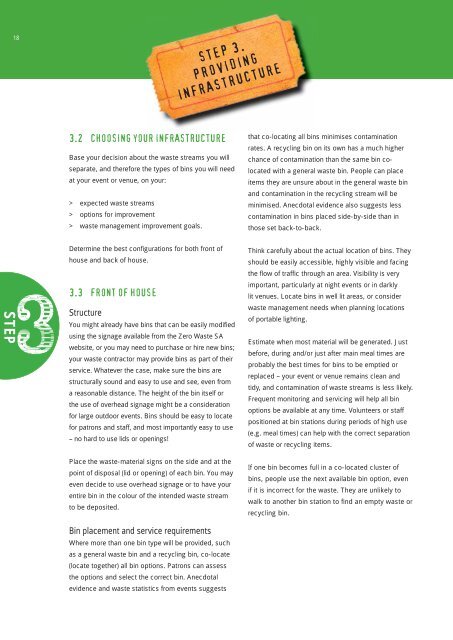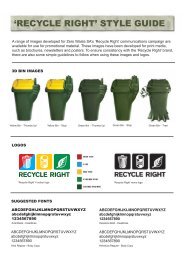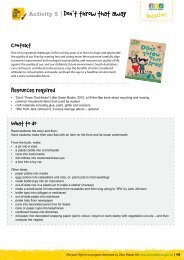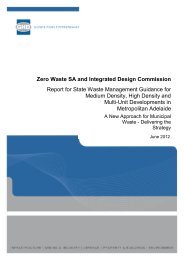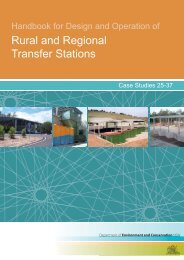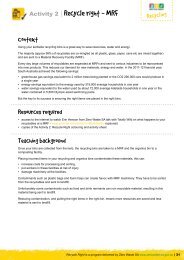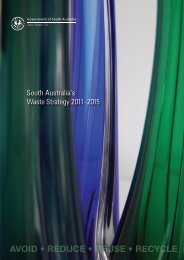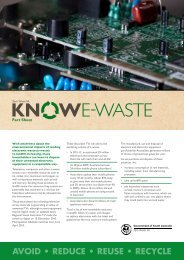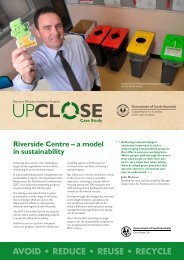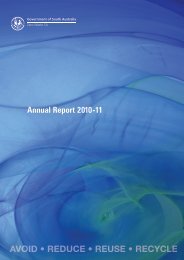Zero Waste SA guidelines for managing waste at events and venues
Zero Waste SA guidelines for managing waste at events and venues
Zero Waste SA guidelines for managing waste at events and venues
You also want an ePaper? Increase the reach of your titles
YUMPU automatically turns print PDFs into web optimized ePapers that Google loves.
18<br />
STEP 3.<br />
PROVIDING<br />
INFRASTRUCTURE<br />
3.2 CHOOSING YOUR INFRASTRUCTURE<br />
Base your decision about the <strong>waste</strong> streams you will<br />
separ<strong>at</strong>e, <strong>and</strong> there<strong>for</strong>e the types of bins you will need<br />
<strong>at</strong> your event or venue, on your:<br />
> expected <strong>waste</strong> streams<br />
> options <strong>for</strong> improvement<br />
> <strong>waste</strong> management improvement goals.<br />
th<strong>at</strong> co-loc<strong>at</strong>ing all bins minimises contamin<strong>at</strong>ion<br />
r<strong>at</strong>es. A recycling bin on its own has a much higher<br />
chance of contamin<strong>at</strong>ion than the same bin coloc<strong>at</strong>ed<br />
with a general <strong>waste</strong> bin. People can place<br />
items they are unsure about in the general <strong>waste</strong> bin<br />
<strong>and</strong> contamin<strong>at</strong>ion in the recycling stream will be<br />
minimised. Anecdotal evidence also suggests less<br />
contamin<strong>at</strong>ion in bins placed side-by-side than in<br />
those set back-to-back.<br />
STEP<br />
Determine the best configur<strong>at</strong>ions <strong>for</strong> both front of<br />
house <strong>and</strong> back of house.<br />
3.3 FRONT OF HOUSE<br />
Structure<br />
You might already have bins th<strong>at</strong> can be easily modified<br />
using the signage available from the <strong>Zero</strong> <strong>Waste</strong> <strong>SA</strong><br />
website, or you may need to purchase or hire new bins;<br />
your <strong>waste</strong> contractor may provide bins as part of their<br />
service. Wh<strong>at</strong>ever the case, make sure the bins are<br />
structurally sound <strong>and</strong> easy to use <strong>and</strong> see, even from<br />
a reasonable distance. The height of the bin itself or<br />
the use of overhead signage might be a consider<strong>at</strong>ion<br />
<strong>for</strong> large outdoor <strong>events</strong>. Bins should be easy to loc<strong>at</strong>e<br />
<strong>for</strong> p<strong>at</strong>rons <strong>and</strong> staff, <strong>and</strong> most importantly easy to use<br />
– no hard to use lids or openings!<br />
Place the <strong>waste</strong>-m<strong>at</strong>erial signs on the side <strong>and</strong> <strong>at</strong> the<br />
point of disposal (lid or opening) of each bin. You may<br />
even decide to use overhead signage or to have your<br />
entire bin in the colour of the intended <strong>waste</strong> stream<br />
to be deposited.<br />
Bin placement <strong>and</strong> service requirements<br />
Where more than one bin type will be provided, such<br />
as a general <strong>waste</strong> bin <strong>and</strong> a recycling bin, co-loc<strong>at</strong>e<br />
(loc<strong>at</strong>e together) all bin options. P<strong>at</strong>rons can assess<br />
the options <strong>and</strong> select the correct bin. Anecdotal<br />
evidence <strong>and</strong> <strong>waste</strong> st<strong>at</strong>istics from <strong>events</strong> suggests<br />
Think carefully about the actual loc<strong>at</strong>ion of bins. They<br />
should be easily accessible, highly visible <strong>and</strong> facing<br />
the flow of traffic through an area. Visibility is very<br />
important, particularly <strong>at</strong> night <strong>events</strong> or in darkly<br />
lit <strong>venues</strong>. Loc<strong>at</strong>e bins in well lit areas, or consider<br />
<strong>waste</strong> management needs when planning loc<strong>at</strong>ions<br />
of portable lighting.<br />
Estim<strong>at</strong>e when most m<strong>at</strong>erial will be gener<strong>at</strong>ed. Just<br />
be<strong>for</strong>e, during <strong>and</strong>/or just after main meal times are<br />
probably the best times <strong>for</strong> bins to be emptied or<br />
replaced – your event or venue remains clean <strong>and</strong><br />
tidy, <strong>and</strong> contamin<strong>at</strong>ion of <strong>waste</strong> streams is less likely.<br />
Frequent monitoring <strong>and</strong> servicing will help all bin<br />
options be available <strong>at</strong> any time. Volunteers or staff<br />
positioned <strong>at</strong> bin st<strong>at</strong>ions during periods of high use<br />
(e.g. meal times) can help with the correct separ<strong>at</strong>ion<br />
of <strong>waste</strong> or recycling items.<br />
If one bin becomes full in a co-loc<strong>at</strong>ed cluster of<br />
bins, people use the next available bin option, even<br />
if it is incorrect <strong>for</strong> the <strong>waste</strong>. They are unlikely to<br />
walk to another bin st<strong>at</strong>ion to find an empty <strong>waste</strong> or<br />
recycling bin.


